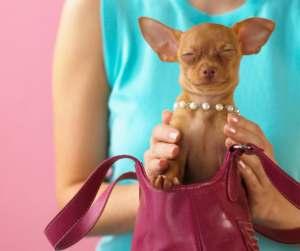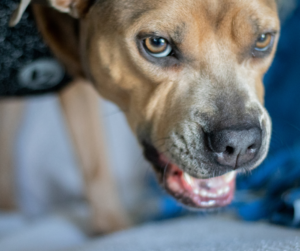Michael Baugh CDBC CPDT-KSA
Dogs are unique as a species in that they come in such varying sizes. It’s easy to forget, but important to remember that they are all dogs. They are far more similar to each other than they are different. Your Chihuahua is as much a dog as your Mastiff. Same with your Fox Terrier, your Bichon Frisé, and your little designer Schnapingfroodle.
 Trouble is, we treat our little dogs differently in ways that understandably lead to aggressive behavior. More than half of the small dog aggression cases I see are related to how the dog is handled. Most of those are owner-directed aggression cases. The way we are touching, holding, swooping in and picking up, poking, prodding and otherwise fussing with our little dogs is causing the problem. We are startling them, scaring them, and pissing them off multiple times per day. We do it when they are playing, when they’re eating, resting, even when they’re sleeping. Our little 8 pound friend is minding her own business. Here we come out of nowhere (20 times her size), yammering away on our iPhone, bag on our shoulder. Then our big primate mit-of-a-hand shovels under her and lifts her airborne without so much as a “good morning, sweetie.”
Trouble is, we treat our little dogs differently in ways that understandably lead to aggressive behavior. More than half of the small dog aggression cases I see are related to how the dog is handled. Most of those are owner-directed aggression cases. The way we are touching, holding, swooping in and picking up, poking, prodding and otherwise fussing with our little dogs is causing the problem. We are startling them, scaring them, and pissing them off multiple times per day. We do it when they are playing, when they’re eating, resting, even when they’re sleeping. Our little 8 pound friend is minding her own business. Here we come out of nowhere (20 times her size), yammering away on our iPhone, bag on our shoulder. Then our big primate mit-of-a-hand shovels under her and lifts her airborne without so much as a “good morning, sweetie.”
Think for a minute what that must feel like for her. Seriously. Take a moment and give it some thought.
I’ve literally seen someone flip a small dog off their lap with their knee. Can’t do that with a Mastiff. Wouldn’t dare with a Malinois. But, the Maltese and the Miniature this-or-that is fair game? No. Just because we can do something with our dogs does not mean we should.
It shocks people when their dog bites them. They tell me it was unprovoked. Thing is we are provoking our little dogs every day. It’s not shocking at all. Animals who feel out-of-control and threatened will do what they need to protect themselves. We can relate to that.
Treat your Chihuahua like a Mastiff.
- If you need your dog to move, direct her visually or verbally (hand targeting is good for this).
- If you want your dog to get into a car or onto furniture, teach her to use steps or a ramp.
- Wake your dog up by calling her name.
- Touch gently.
- If you must lift your dog, give her fair warning. Pause. Pet. Talk to her. Then lift. (If it’s a Mastiff you’ll need some help).
- If your little dog has already bitten, you will need to call in help from a qualified dog behavior consultant or veterinary behaviorist. We have some relationship healing to do. The good news is these cases often resolve well. We just need to learn how to behave better so that our dog can too.
Then, gently, pick her up. Give her some lovin’. Put her in that cute handbag. You two are a fabulous couple.
Michael Baugh teaches dog training and behavior. His next dog will be a size small. He and his spouse, Tim, already have the sling carrier picked out.


